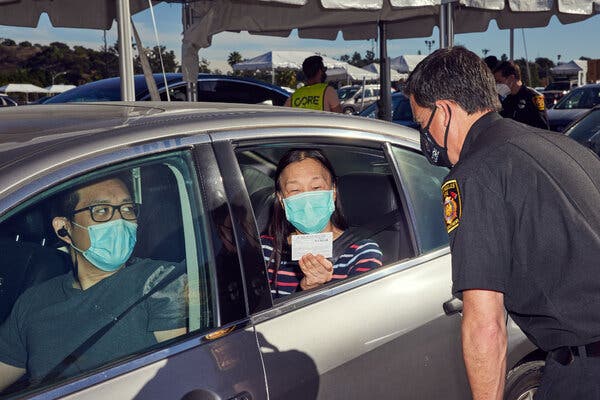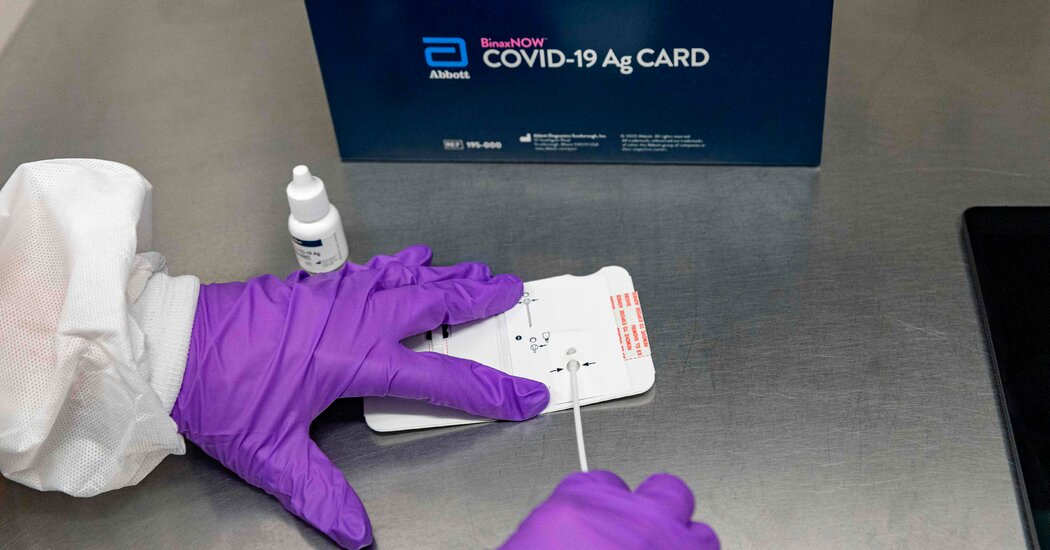Covid-19 Vaccine Card Guide: Keeping it Safe, Travel, Information, Passport and Benefits
For now, the best way to show that you’ve been inoculated against the coronavirus is a simple white card. Here, your key questions answered.As vaccinations become more widely available for people in the United States and travel starts picking up, many people have started sharing their simple white vaccination cards on social media as prized new possessions.With some destinations, cruise lines and venues already requiring travelers to provide proof of vaccination against Covid-19, keeping that record is key. In New York, for example, proof of vaccination or a recent negative test will be required for entry into large venues or catered events when they are allowed to reopen at reduced capacity on April 2. Proof will be required at events with more than 100 people, so anyone having a wedding or Sweet 16 with more attendees will have to ask guests for evidence that they are complying with the rules.There are already a number of vaccination “passport” initiatives underway that would make vaccination status easy to share digitally. Clear, a biometric screening program used in airports across the country, and the technology company IBM have created their own passes, for instance. And last week, New York became the first state to introduce a digital tool to allow people to easily show that they have either tested negative or been inoculated against the virus in order to gain entry into some events and venues.But until such measures are taken more widely across the country, you’ll want to hang onto that little white card.Here’s everything you need to know about your vaccine record, why it’s important and how to keep it safe.A newly inoculated patient reviewed a Covid-19 vaccination record card at Dodger Stadium in Los Angeles in January.Ryan Young for The New York TimesWhat’s on your vaccine card?The vaccine card, given after your first shot and then updated if your vaccine requires a second one, includes the vaccine manufacturer, the dose numbers and the date and location each was administered, according to Alex Brown, a spokeswoman for Walgreens, which is administering vaccinations at more than 5,000 stores nationwide.Walgreens, like other providers, is looking to make its records digital, Ms. Brown said, but for now it is still handing out cards.Walmart and Sam’s Club are already offering their patrons digital access to their vaccine records through both the Health Pass by Clear and the CommonHealth and CommonPass apps from the Geneva-based nonprofit, the Commons Project Foundation.“Our goal is to give customers vaccinated at Walmart free and secure digital access to their vaccine record and enable them to share that information with third parties seeking to confirm their vaccination status,” John Furner, the chief executive officer and president of Walmart U.S., said in a statement.What happens if I lose my card?Getting a new card is easy enough if you got vaccinated at a pharmacy like Walgreens. Ms. Brown said that anyone who loses their card should return to where they were vaccinated and a pharmacy employee can print out a new card from the patient’s electronic records.A member of the Walgreens vaccination team prepared vaccination cards for the staff and residents of Clove Lakes Nursing Home in Staten Island in January.Christopher Occhicone for The New York TimesVaccinations are also tracked by state health departments, so you can reach out to your state’s agency to get a replacement card, according to the Centers for Disease Control and Prevention. The agency lists contact information for the Immunization Information System in each state, which tracks vaccinations, on its website.How should I safeguard my card?Start by taking a picture of it with your phone, so you’ll have the information in your photo library, and emailing it to yourself as backup, said Dr. Uchenna Ikediobi, an assistant professor of general internal medicine and infectious diseases at Yale University.Laminating your card will make it more durable if you’re planning to carry it around in your wallet, though there has been some concern about lamination because it would prevent information from future booster shots from being added. But Dr. Ikediobi said that this “may be a moot point if new cards are issued after a booster shot, as would seem likely.”A number of companies have jumped in to offer free lamination. Staples is offering free lamination of vaccine cards for those who have gotten their doses, according to Jocelyn Moruzzi, a spokeswoman for the office goods retailer. The offer is valid at all of the company’s United States locations with the offer code 81450 and does not yet have an end date.“Customers began seeking out ways to protect their Covid-19 vaccine record cards, knowing they will likely be important to have on hand in the future,” Craig Grayson, vice president of print and marketing services for Staples, said in an email on Wednesday. “Leveraging our existing capabilities in store felt like a natural way to provide a free solution.”People can also get their completed vaccine cards laminated for free at Office Depot and OfficeMax stores nationwide using the code 52516714 through July 25.Dr. Ikediobi also recommends keeping the card in a safe place, as you would your passport, rather than carrying it around. “It does not necessarily need to be on your person at all times,” she said.Do I need my card to travel?In some cases, yes. Some destinations and cruise lines have started requiring that travelers be fully vaccinated before they travel. As of March 26, fully vaccinated Americans who can present proof of vaccination can visit Iceland, for example, and avoid border measures such as testing and quarantining, the country’s government said.The cruise line Royal Caribbean is requiring passengers and crew members 18 or older to be vaccinated in order to board its ships, as are Virgin Voyages, Crystal Cruises and others. These companies will restart cruise operations this spring and summer. None of the companies are yet operating cruises out of United States ports, because the C.D.C. has yet to give them the guidelines they’ll need to follow.For the moment, airlines are not requiring vaccinations for travel. But the idea has been much talked about in the industry. In an interview with NBC Nightly News recently, Ed Bastian, the chief executive officer of Delta Air Lines, said that proof of vaccination will likely eventually be required on international flights, but whether that is paper proof or a digital vaccine passport, is unclear.Will New York require a vaccine passport?Gov. Andrew Cuomo last week announced the launch of Excelsior Pass, a free app that will allow businesses to scan a code to confirm whether someone has been vaccinated or tested negative for the coronavirus. To sign up, New York residents should visit the Excelsior Pass website, where they will be asked to enter their name, date of birth and ZIP code. A pass — a QR code that can be scanned by businesses — will automatically be generated using data from state vaccination records or testing lab data.No one is required to download Excelsior Pass, according to a spokesman for the governor’s office. The pass generated on the website can be printed out, or you can show your vaccine card or evidence of a negative test result instead.Will the Biden administration require a vaccine passport?Among the Biden administration’s executive orders aimed at curbing the pandemic is one that asked government agencies to “assess the feasibility” of producing digital versions of vaccination documents. But while the government is involved in these efforts, the administration has said that it would not be passing a federal mandate or distributing its own vaccine passport.In a White House Covid-19 news conference on Monday, Andy Slavitt, the acting director for the Centers for Medicare and Medicaid Services, said that “unlike other parts of the world, the government here is not viewing its role as the place to create a passport, nor a place to hold the data of citizens.”“We view this as something that the private sector is doing and will do,” he said. “What’s important to us — and we’re leading an interagency process right now to go through these details — are that some important criteria be met with these credentials,” including equitable access and privacy and security concerns.The Krispy Kreme chain is offering one free glazed doughnut a day to anyone who presents proof of Covid-19 vaccination. Timothy A. Clary/Agence France-Presse — Getty ImagesAre there other benefits?Yes. Aside from the health benefits of getting the vaccine, there are also other perks that come with your vaccine card. Businesses across the country, from bars to marijuana dispensaries, have been offering perks to those with a Covid-19 vaccination card. Krispy Kreme, for instance, said last week that for the rest of the year, it would give one free glazed doughnut per day to anyone who presents proof of a Covid-19 vaccination.Michael Tattersfield, the company’s chief executive, told Fox News that as vaccinations have accelerated across the country, “We made the decision that, ‘Hey, we can support the next act of joy,’ which is, if you come by, show us a vaccine card, get a doughnut any time, any day, every day if you choose to.”Follow New York Times Travel on Instagram, Twitter and Facebook. And sign up for our weekly Travel Dispatch newsletter to receive expert tips on traveling smarter and inspiration for your next vacation. Dreaming up a future getaway or just armchair traveling? Check out our 52 Places list for 2021.
Read more →





